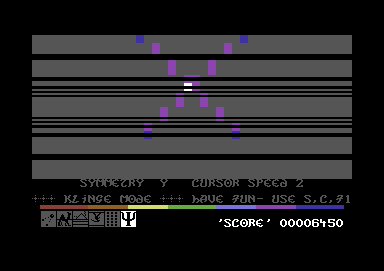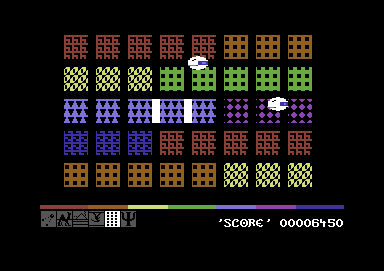Retro Replay Review
Gameplay
Batalyx delivers a bold fusion of six distinct mini-games, each driven by Jeff Minter’s trademark high-octane mechanics and surreal enemy designs. The game’s core loop revolves around filling credit meters and completing sections to earn fragments of five completion icons. All of this plays out under the pressure of an ever-depleting time bar, forcing players to juggle speed, precision, and adaptability.
(HEY YOU!! We hope you enjoy! We try not to run ads. So basically, this is a very expensive hobby running this site. Please consider joining us for updates, forums, and more. Network w/ us to make some cash or friends while retro gaming, and you can win some free retro games for posting. Okay, carry on 👍)
In “Hallucino-bomblets,” you pilot a reactive probe that thrusts in the opposite direction of each shot, navigating a shifting field of floppy disks, beer pints, and other off-kilter adversaries. Accumulating credits through enemy destruction and avoiding collisions adds a strategic layer, since overzealous ramming can cost you precious progress. When a credit bar maxes out, you claim part of your first icon.
“AMC2 (Attack of the Mutant Camels 2)” reignites the classic camel-blasting action. A radar display tracks the lumbering beasts as they march toward your base. Rapid fire and careful positioning are vital to keep them at bay. Survive the onslaught, then dodge inbound missiles in the warp segment to secure another icon piece.
“Activation of Iridis Base” is essentially a Simon-style memory challenge set against the backdrop of a pyramid seen from atop a camel’s rump. You replicate sequences of joystick motions (with optional fire-button embellishments) to balance photon streams. Mastery hinges on both concentration and muscle memory.
“Cippy on the Run” revives Minter’s goat-like sprite, tasking you with turning every floor and ceiling tile rainbow-bright. While you auto-fire to repel foes, each enemy collision can scrub tiles back to drab hues. Negotiating gaps and non-sticky surfaces without losing your tile-painting momentum is key.
“Synchro II” ranks as the toughest trial. Here, patterned floor panels shift as you hold fire and slide the joystick, and your goal is to lock enemy probes in place by aligning the patterns. It’s a puzzle-action hybrid that demands precision timing and forward thinking.
Finally, “Psychadelia 2” isn’t so much a game as a trippy light synthesizer—an interlude allowing you to tweak background colours, symmetry axes, and line lengths. It serves as both palate cleanser and a nod to Minter’s long-standing love affair with audiovisual spectacle.
Graphics
Batalyx radiates with neon-soaked visuals that feel like a retro rave on fast-forward. Each mini-game sports its own palette, from the acid-trip shapes in Hallucino-bomblets to the sunbaked dunes of AMC2, yet the entire package maintains a cohesive, otherworldly sheen.
In Hallucino-bomblets, enemies and backgrounds swirl in psychedelic patterns, giving every shot and thrust a hypnotic flourish. Animations remain fluid despite the onslaught of objects, and the colour choices perfectly complement the game’s anarchic spirit.
AMC2’s desert vistas are rendered with chunky pixel cactuses and caricatured camels, all framed by a crisp radar interface. The warp section accelerates into streaking missiles and starfields, providing just enough visual clarity to balance the chaos.
Activation of Iridis Base leans heavily on geometric precision. The camera angle from the camel’s rear offers a rotating view of the pyramid’s neon facets. Each photon-beam sequence lights up the screen in sharp, memorable bursts.
Cippy on the Run bathes every floor tile in rainbows. Watch as drab surfaces flip to vibrant stripes under your feet, while enemy sprites pop against the technicolour backdrop. The contrast between sticky and non-sticky zones is always clear, helping you strategize tile control on the fly.
Synchro II opts for minimalism, presenting grids of high-contrast squares that slide in rhythmic patterns. When the floor synchronizes, enemy probes freeze in place, and the effect is both satisfying and visually striking.
Psychadelia 2 unleashes the full spectrum of digital light shows, offering real-time toggles for symmetry, hue rotations, and line frequency. It’s a spectacle rather than a game, a perfect breather between intense bouts of action.
Story
Batalyx foregoes a traditional narrative in favour of a thematic through-line: the collection of five mysterious icons within a cosmic time frame. This minimalist approach places the emphasis firmly on gameplay variety and rhythmic progression rather than character arcs or plot twists.
Each mini-game carries its own micro-premise. You might be blasting mutant camels to protect a base, riding a camel toward a glowing pyramid, or guiding a probe through kaleidoscopic zones. These vignettes are tied together by Jeff Minter’s signature penchant for oddball enemy rosters and surreal settings.
The overarching tension comes from the ever-ticking time bar, which serves as both your guide and your adversary. Completing a segment not only advances you mechanically but also symbolically edges you closer to the final icon—and the game’s intangible “narrative” of cosmic mastery.
Psychadelia 2 acts as a narrative intermission, giving players a moment to decompress in a purely audiovisual environment. In a way, this segment becomes its own story: one of colour, symmetry, and meditative calm before diving back into the fray.
Overall Experience
Batalyx offers a singular blend of frantic action, puzzle-like choreography, and hallucinatory visuals. The sheer variety on offer—six games in one—ensures that no two play sessions feel the same. Each mini-game feels lovingly crafted, showcasing Jeff Minter’s decades of expertise in marrying arcade intensity with idiosyncratic design.
The global time limit adds a layer of strategy that elevates the package from a mere “collection” to a cohesive marathon challenge. You’ll constantly weigh which mini-game to tackle next, balancing your strengths against the ticking clock. This resource-management aspect keeps adrenaline high and stakes palpable.
While there’s scant narrative to speak of, Batalyx’s abstract storytelling through mechanics and visuals will resonate with those who appreciate games that communicate mood rather than text. Fans of classic arcade pursuits, high-score chasing, and psychedelic aesthetics will find a lot to love here.
That said, newcomers to Minter’s style should be prepared for a learning curve. Controls can feel twitchy at first, and some mini-games—especially Synchro II—demand patience and precision. But conquering these challenges delivers a genuine sense of accomplishment.
In sum, Batalyx stands as a vibrant tribute to arcade diversity and Jeff Minter’s indelible creative vision. It’s highly replayable, visually intoxicating, and mechanically rich—making it a compelling pick for anyone seeking offbeat thrills and retro-inspired intensity.
 Retro Replay Retro Replay gaming reviews, news, emulation, geek stuff and more!
Retro Replay Retro Replay gaming reviews, news, emulation, geek stuff and more!









Reviews
There are no reviews yet.